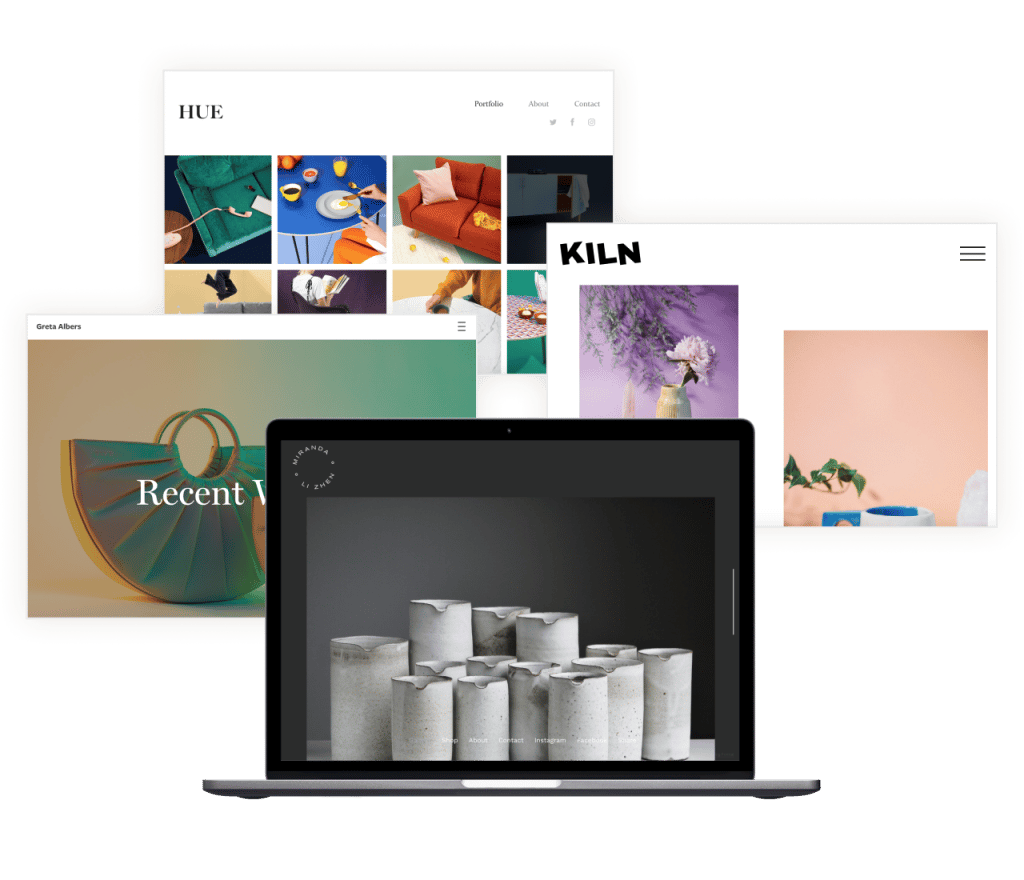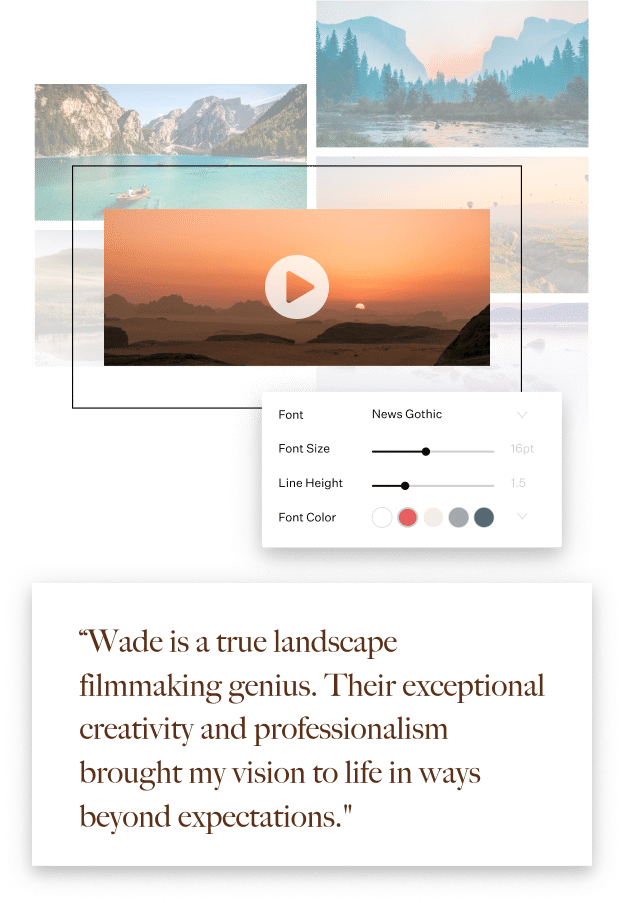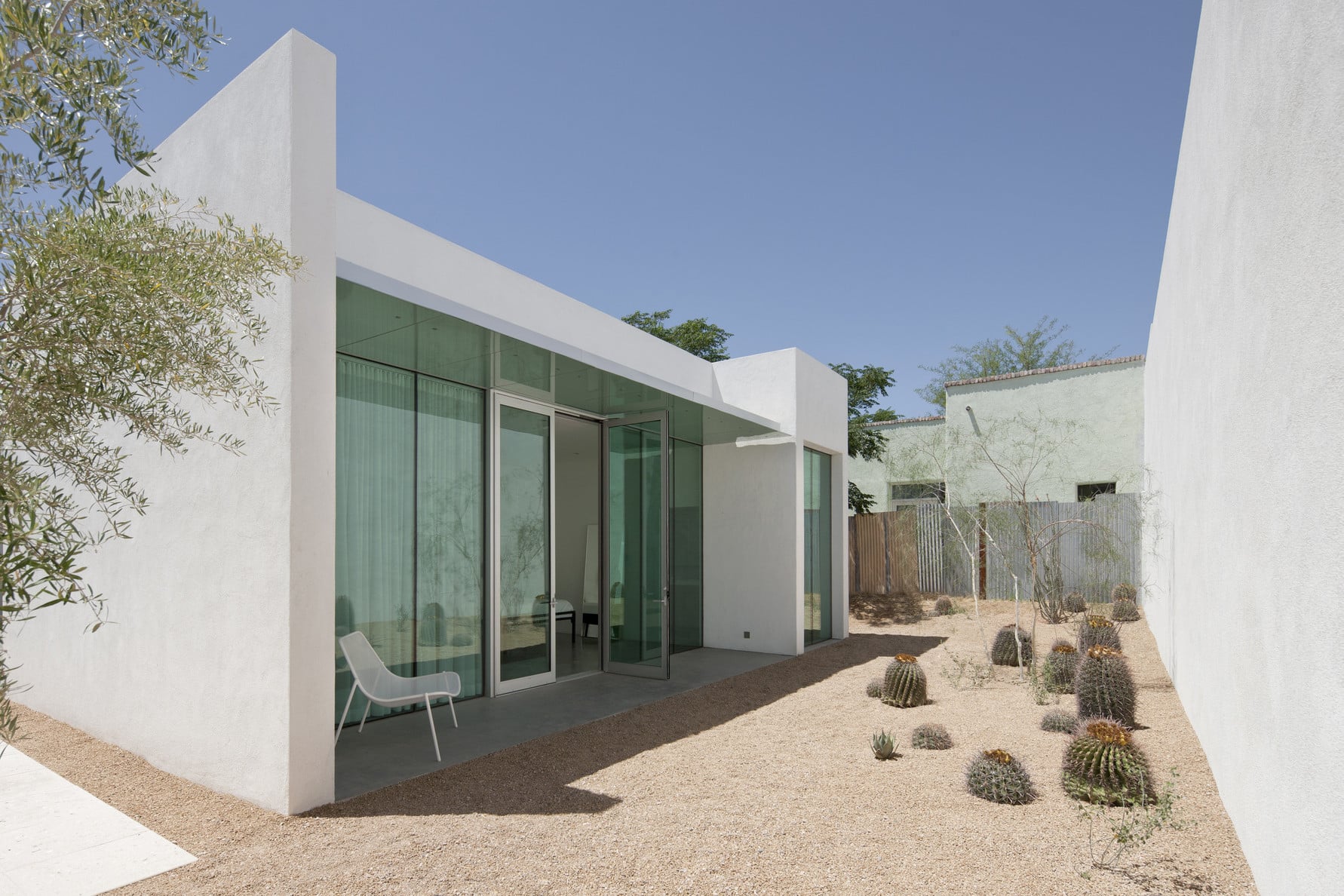Have you been struggling to create your portfolio homepage to showcase your skills, talent, and expertise? Sometimes the traditional boundaries of creative industries blur, making building a well-crafted portfolio much more important. While a portfolio homepage is a great way to self-promote your services, its purposes go much further than that.
A portfolio homepage is a virtual gateway that offers potential clients, collaborators, and employers a brief glimpse into an individual’s creative expression, experience, and capabilities. It offers an individual a unique way to explain their creative process while also expressing what their brand offers. A portfolio homepage gives creative professionals an outlet to present their work in the best way possible.
A creative portfolio homepage can be thought of as a digital calling card for individuals advertising their creative services. A well-designed portfolio homepage should be curated with a seamless user experience that will guide website visitors through a narrative that tells a story behind the creative. It should evoke emotions, engage with audiences, and leave a lasting impression that will cause visitors to act.
In this article, we’ll give you a step-by-step guide to creating your own portfolio homepage. We’ll highlight the importance of choosing the right platform for your needs, explain the importance of design and layout functionality, how to showcase your best work, create a story behind your brand, and more!
1. Choose the Right Website Builder
When you’re looking to start your creative portfolio homepage, choosing the right website builder is important to growing your online presence. While many options are available on the market, it’s helpful to evaluate each one carefully to ensure it aligns with your needs.
Evaluate different platforms
Before starting a creative portfolio homepage, it’s essential to take the time and research various website builders. With so many website builders available, narrowing them down to what will work for you can feel intimidating. Each has its own pros and cons, integration capabilities, and costs.
Consider customization options
Another important factor to consider when building your creative portfolio homepage is how customizable it is. Creative professionals tend to gravitate toward options they can tailor to suit their overall style. A homepage builder should come loaded with customizable layouts, typography, color schemes, and ways to adjust aesthetics. Showcasing your creative work should be done in a visually appealing way that always leaves a lasting impression on potential clients and website visitors.
Compatibility
Another often overlooked factor in creating a portfolio homepage is finding a platform that integrates with many of the tools you already use or are planning to use in the future. The last thing you want is to create a portfolio homepage only to later realize it’s not functional with your file formats or third-party integrations.
Aligns with your budget
Lastly, your chosen platform or website builder should closely align with your budget. Take a look at pricing models that are offered by different platforms. You’ll also want to look at domain registration, hosting, and SSL certificate fees. Some platform builders and domain hosts already have these things included, which is a bonus.
Considering these factors while looking for a website builder will bring you one step closer to deciding on one that works for you. At Format, we offer an easy-to-use portfolio creation solution that offers the following:
- Customizable templates that can help you create a stunning portfolio website in minutes.
- Unlimited storage for your images and videos.
- Client proofing tools that allow you to share your work with clients and get feedback.
- E-commerce integration that allows you to sell your work directly from your website.
- SEO optimization to help your website rank higher in search engine results pages (SERPs).
- Mobile-responsive design that ensures your website looks great on any device.

2. Design and Layout Considerations
Capturing the attention of your visitors plays a vital role in whether they’ll decide to contact you for services or end up leaving your website. There are a couple of options to showcase your work in a way that will engage with your audience in the best ways possible.
Choose a visually appealing and intuitive design
The design you choose should complement your creative style and the overall type of work you do. For example, if you’re a wedding photographer, you may want to highlight portfolio pieces that showcase your best work without overwhelming the viewer with fancy colors all over the page. In a situation like this, you might want to go for a cleaner, more organized design that will keep your work as the focus more than the colors on your website.
Organize your content
All of the content on your portfolio homepage should be organized in a logical and coherent way. Suppose you’re a photographer that offers many types of photography services across different genres. In that case, you may want to create sections, subsections, and categories based on the types of photography you do. This means you shouldn’t combine wedding and food photography in the same sections. Additionally, try to include clear and concise headings that will help your visitors understand your work.
Navigation structure
Navigation structure piggybacks off of effectively organizing your content. Your portfolio homepage should be easy to navigate through and allow the visitor to understand what you offer. You should keep your menu items concise without overwhelming your audience with so many options that they become confused and don’t end up selecting any. Sometimes it helps to include a filtering function on your website that allows users to discover your content easier.
Optimize for mobile devices
These days, roughly 80% of users surf the internet through their mobile phones. If your portfolio homepage isn’t optimized for mobile use, you could miss out on many potential clients interested in your services. Ensure your homepage adapts to various screen sizes and resolutions. Before finalizing your page, test it out on various mobile devices to ensure everything is displayed properly. Many platforms allow you to view how a page looks on different types of mobile devices.
Now that you know more about design and layout configurations, let’s move on to how you should showcase your work to reach a broader audience.
3. Showcase Your Best Work
You should always showcase your best work to leave a lasting impression on your visitors.
Curate a selection of your top projects
Instead of bombarding your audience with a vast selection of your work, you should focus on using only the ones you feel best represent your work. Quality over quantity is what matters most here. If you’re advertising food photography services, try including the best shots in your portfolio.
Highlight variety and depth in your portfolio
If you’re a photographer skilled in many different types of photography styles, try to include the best examples of each one on your portfolio homepage. As mentioned earlier, you should also categorize your work accordingly. Try to group food product photography photos, wedding photos, and landscape photos in their own sections.
Include description and context for each project
For customers to understand your work better on your creative portfolio homepage, it helps to include descriptions to put things into context. Try to briefly describe the objectives or outcomes of each photo or group of photos you use. To connect with website visitors on a deeper level, it also helps to include unique aspects that make each project memorable.
Use multimedia elements effectively
Incorporating multimedia elements into your creative portfolio homepage will retain the attention of your videos. Try including high-quality images, videos, and other interactive features that help to highlight all of your best work. Using multimedia elements is a good way to create a story around your work.
4. Craft Compelling Copy
Crafting compelling copy that will convey the essence of your work is also just as important as showcasing some of your best work on your homepage. Your copy should clearly communicate your talent and expertise.
Write a captivating headline
To grab your audience’s attention right from the beginning of your homepage, you should write a captivating headline that efficiently delivers your unique selling proposition and style. Try to use language that will pique the curiosity of your visitors and will entice them to scroll further through your website. Keywords or phrases that reflect your specific niche will have your content reaching your target audience.
Create an engaging introduction
Your introduction is your chance to shine as a creative professional. Keep it as concise as possible while highlighting what you offer your customers and what sets you apart from your competitors. Your introduction aims to inspire your target audience to stay connected to your portfolio and scroll through the rest of your page.
Describe your creative process and approach
An excellent way to connect with customers is to describe your creative process and how you can bring ideas to life. Try to share some of the inspirations behind your work and why you made some of the decisions related to your photos. This reveals your ability to problem-solve as a creative professional and allows website visitors to see things from your perspective.
Highlight key accomplishments and milestones
It also helps to highlight some of your most significant accomplishments as a creative professional on your portfolio homepage. If you’ve won any awards or recognition in the past, use persuasive language to articulate that.

5. Incorporate Testimonials and Client Feedback
Incorporate testimonials and client feedback on your homepage to establish credibility and increase social proof. Let’s take a look at a few important considerations for using testimonials and client feedback.
Request testimonials from satisfied clients or collaborators
Try to contact clients in the past that were highly satisfied with your work and request some of their feedback that you can showcase on your creative portfolio homepage. It’s helpful to keep things as specific as possible here. Include details about your work’s impact on their lives and what they appreciated most about it. Additionally, you should make providing feedback on your website as easy as possible.
Showcase positive reviews
Try to showcase the most positive reviews on your website first. Focus on testimonials that highlight your professionalism, talent, and creativity.
Use testimonials strategically to reinforce your credibility
In addition to keeping a dedicated section for testimonials, you’ll also want to place testimonials in other areas of your website, such as the homepage banner or right beside portfolio projects.
6. Personalize Your Homepage
To create a genuine connection with your target audience, personalize your creative portfolio homepage to differentiate yourself from your competitors. When personalizing your homepage, there are a few things you should consider.
Showcase your personality
Let your personality shine through on your creative portfolio homepage. This might seem like a difficult task to do on a homepage, but with the help of customizable design aesthetics, color palettes, and typography choices, you can figure out a style that leaves a lasting impression of authenticity about who you are.
Consider sharing personal anecdotes
Another way to personalize your homepage is to include personal anecdotes related to your journey of becoming a creative professional in the first place. Doing this will humanize your page and give visitors and potential clients a better idea of how you’ve grown into who you are today.
Share some interests and hobbies
Consider sharing a few details about your personal hobbies or interests. Many travel photographers became travel photographers because it used to be their hobby. People that love what they do are usually very good at it, and by allowing visitors a glimpse into your interests, they may also become more interested in choosing you for their projects.
Use authentic language
Try to avoid the use of industry-specific terms that can end up leaving your target audience more confused about what you offer. Use language (the text on your site) simple but conversational and aligns with your voice.
7. Implement Effective Calls-To-Action (CTAs)
A good creative portfolio homepage should have CTAs where visitors can take action. Some examples of CTAs include contact buttons that visitors can click to reach out to you easily, newsletter subscriptions, or links that lead to more of your portfolio. There are a few strategies to keep in mind with this step.
When designing your CTAs, you should figure out the actions you want your visitors to take. You need to ask yourself a couple of questions here:
- Do you want them to contact you for collaborations?
- Do you want them to view your entire portfolio?
- Do you want more visitors to subscribe to your newsletter?
Strategically place CTAs throughout your homepage
For the biggest impact, your CTAs should be placed in highly visible areas of your website. Some of the best locations for CTAs are the header, sidebar, and footer. It’s also helpful to place CTAs right after showcasing some of your best work.
Keep CTAs concise
Your CTAs must effectively communicate the overall benefit visitors will receive upon taking the desired action. Examples of action-oriented language for CTAs should be things like:
- “Contact me.”
- “Explore more of my portfolio.”
- “Subscribe to my newsletter.”
8. Optimize for Search Engines
To make sure your creative portfolio homepage reaches your target audience, it needs to be optimized for search engines. Search engine optimization (SEO) includes strategies to improve your website’s ranking in search engines.
Keyword research
The first step in optimizing your creative portfolio homepage for search engines is conducting keyword research. Some people use Google Keyword Planner, Moz, or SEMrush to identify relevant keywords with high search volumes and lower competition.
Use the keywords in your content
After researching relevant keywords, include these keywords in your website content. For the best results, include keywords in the headlines, subheadings, body text, and image captions.
Page loading speed
Another considerable factor in SEO is how fast your page loads. Faster-loading portfolio homepages improves the overall user experience and increases engagement.
9. Integrate Social Media and Contact Information
As the world has become more interconnected due to social media and the internet more broadly, you should use that to enhance your online presence. There are two things you should do here.
Link your social media profiles
Integrate your social media profiles onto your creative portfolio homepage. Directing visitors to your social media pages is an excellent way to show more of your work and behind-the-scenes insights. Choose a layout where the social media icons are easy to locate on the homepage.
Provide your contact information
You’ll want to ensure visitors don’t have any issues contacting you. Include your email address and phone number in your website’s header or footer. For the most seamless visitor experience, also create an about page with contact information and your cv, or a contact page, that they can locate in your site menu on your homepage.
Get Started on Building Your Creative Portfolio Homepage Today
If you’re looking for the best way to build your creative portfolio homepage and reach a wider audience, we recommend giving us a try! Format is a leading platform that provides all the necessary tools and features to bring your vision to life.
With Format, you gain access to a user-friendly website builder tailored exclusively for creative professionals. Format offers beautifully designed templates, customizable layouts, and a seamless drag-and-drop interface, allowing you to effortlessly create a visually stunning portfolio that represents your unique style effortlessly.
To get started building your creative portfolio homepage with Format, try it free today. Whether you’re a photographer, designer, artist, architect, or other in another creative profession, Format provides the tools and support you need to build a professional and visually captivating portfolio that leaves a lasting impression.








